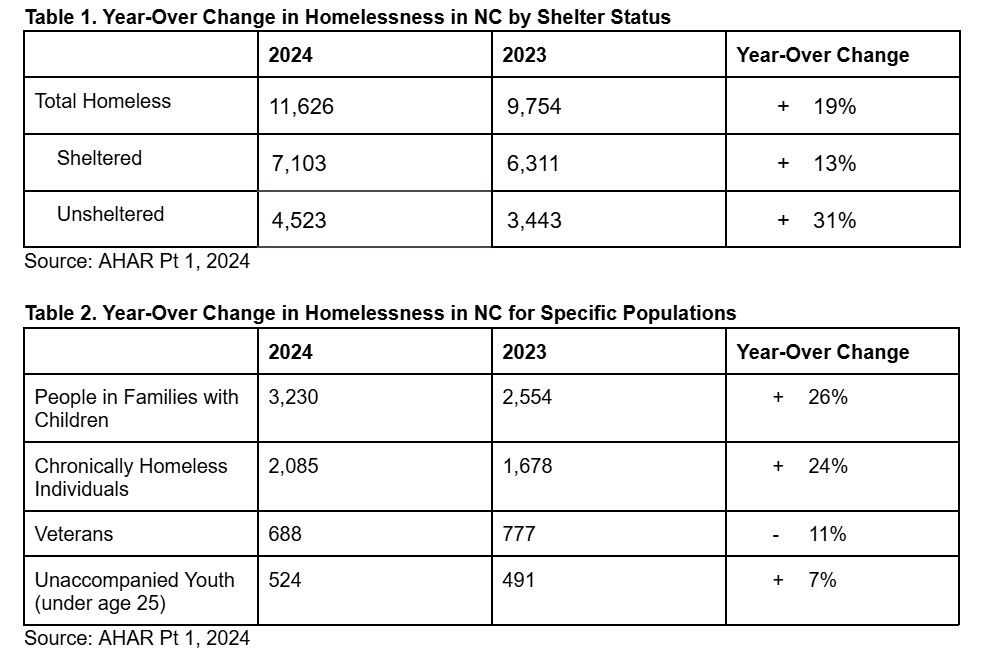Last month, the Department of Housing & Urban Development (HUD) released Part 1 of the 2024 Annual Homelessness Assessment Report (AHAR). This report features data from the annual Point in Time (PIT) count, which aims to provide a tally of every person experiencing homelessness and shelter inventory in each community across the US. Trends that emerge from the data inform policies, programmatic decisions, and funding for vital resources such as emergency shelters.
Trends & Highlights
Nationally and statewide, homelessness continued to trend upward in 2024. Part 1 of the AHAR report provides valuable data about subpopulations and demographic shifts from year to year.
Key National Highlights from the 2024 AHAR: Part 1:
- Homelessness in the U.S. reached record-high numbers. Roughly 771,480 Americans were experiencing homelessness in January 2024 – more than any previous year since HUD began collecting PIT data in 2007. From 2007 to 2020, the number of people experiencing homelessness remained steady, and even decreased some. Since 2020, numbers have sharply increased (by almost 200,000 people) – a result most experts attribute to rising housing costs and the sunsetting of pandemic-era programs and policies designed to help keep people housed.
- Almost all subpopulations that AHAR tracks (individuals, families with children, unaccompanied youth, individuals with chronic patterns of homelessness, etc.) reached record-high levels of homelessness. Veterans were the only population that saw a decrease in homelessness. The report explains that funding and programs designed to address homelessness among veterans led to an overall decrease of about 2,700 veterans experiencing homelessness since 2023, demonstrating that the right policies, programs, and funding can make homelessness one-time, brief, and ultimately solvable.
- One in five individuals experiencing homelessness is 55 or older. Almost half (46%) of people aged 55+ experiencing homelessness are experiencing unsheltered homelessness, meaning they are living somewhere not meant for human habitation.
Key Statewide Highlights from the 2024 AHAR: Part 1:
- The overall number of people in NC experiencing homelessness rose 19% from 2023 to 2024 (see Table 1). The report attributes this increase to a mix of rising unaffordability and improved outreach and data collection methods. Specifically, increased community partner participation in PIT count and expanded Coordinated Entry access points aid CoCs in collecting more accurate data.
The number of North Carolinians in families experiencing homelessness increased by 26 percent (see Table 2). A total of 3,230 adults and children across the state are part of families experiencing homelessness.

Analysis from NC Coalition to End Homelessness
During this week’s Housing Call, Dr. Latonya Agard, Executive Director for the North Carolina Coalition to End Homelessness (NCCEH) discussed the findings in the 2024 Annual Homelessness Assessment Report (AHAR), Part 1. When reviewing the statewide trends, Agard notes, “We’ve seen these numbers increase over and over and over. The largest increase we’ve seen is with the unsheltered homeless population. These are our most vulnerable people and that increase was 31.4% from 2023 to 2024. There are over 4,500 [North Carolinians] in 2024 who were counted as unsheltered. What the trend tells me is that we’re just not doing enough.”
Despite the continued rise in homelessness, Agard remains optimistic. “My hope is that in the midst of this, we will find more collaboration and more innovation to solve the problems that we know are only going to increase without our participation.”
Data Limitations
The PIT methodology has its limits. The data provides a snapshot about who is experiencing sheltered and unsheltered homeless on the night of the count, rather than over the course of the year. Shelters that receive HUD funds are required to participate in the PIT count, but other shelters can be less willing to share their data.
In addition, counting the unsheltered homeless population is difficult. Larger urban areas often benefit from more volunteers and larger Street Outreach teams. Rural counties often lack the capacity for street outreach and accurate counts of unsheltered homelessness.
A big thank you to Dr. Latonya Agard for joining our Housing Call this week! You can listen to the call and review the call notes through our website or through our Housing Matters 2 NC podcast on Spotify and Apple Podcasts. If you are interested in hearing more about this topic or have suggestions for others that you’d like us to dive into, please email Anna Patterson at apatterson@nchousing.org.








